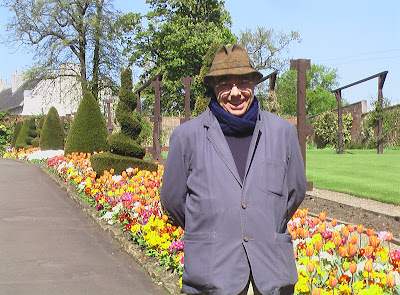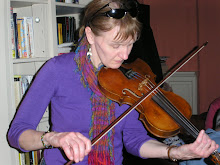 April 26, 2011
April 26, 2011 Welcome to my blog about the fourth Scotland adventure I’m leading for weavers, spinners, knitters and their traveling companions. I'm happy to be fiddling, walking, and well, mostly riding around Scotland once again. Folks ask why I do this trip. The simple answer is, I love the country and it’s people. In a nutshell, I spent the summer of 1997 in Scotland hiking and roaming, meeting farmers, weavers, felters, fiddlers, and singers. That is when I hatched my idea to bring folks who like music, old stones, and weaving to Scotland to meet my friends! It took 10 years, but in 2007 I brought my first group from North America over. I’ll keep leading this trip as long as people are interested in getting an insider experience into the spirit of this place and its people.
This group includes travelers from Canada, both coasts of the US, New Mexico, Arkansas, and the Midwest. For some it is their first time out of North America. Others are regularly on the road. We have a wide mix of backgrounds from sheep growers to an herbalist, an astronomer, a chemistry professor, a teacher, a social worker, a nurse, and avid volunteers. There is a mother and daughter, a father and a daughter, individual travelers, and several couples. We range in age from age 21 to age 87. It is an interesting mix of folks that I already know ask excellent questions of our guides.
Our first stop wa


Charles died in 1928, poor and virtually forgotten, and Margaret died in 1932. Their marriage was a true love story. Today, people world wide value the design aesthetic we today call "Mackintosh" There are many other sites in the Glasgow area that feature the architecture and interiors of Charles Mackintosh. The House for an Art Lover might be a go
Jenell P. playing the piano at House for an Art Lover (DM)
The walled garden at the House was in full spring glory. Here are Gordon M. and Linda L., Linda Ry. and Elaine P. enjoying the brilliant sunshined start to our tour (DM)

The Burrell Collection, is also housed in a museum in Pollok Park. Sir William Burrell amassed great wealth in the shipping business and spent his money on collecting artwork from all over the world. The family gave the collection to the city of Glasgow. There are many tapestries in the collection.
Dina Ward, an enthusiastic volunteer docent, guided us through the tapestries on display. The collection includes large and small tapestries from Flanders, Brussels, and France. Most of the tapestries are currently not displayed as the museum is getting ready to photograph them for a publication. I really enjoyed Dina's i

Large tapestries were woven in Flanders and France. Brussels was a major weaving center in the 1500's. By this time the royalty were commissioning most of the tapestries. Henry VIII was reported to own over 2000 tapestries. “Prudence Arriving at the Temple of the Divine Wisdom” approximately 5 x 12 meters, was woven on its side w

The day ended with an optional visit to the Kelvingrove Museum not too far from our lodging in the West End, Glasgow. Some of the travelers who arrived in advance of the tour heard the daily organ concert in the great hall of the museum. Since the refurbishment a few years ago, it is the number one visited museum in Scotland. It has a vast variety of objects from elephants to the famous Salvador Dali painting "Christ of Saint John of the Cross " www.glasgowlife.org.uk/museums/our-museums/kelvingrove/Pages/home.aspx












No comments:
Post a Comment